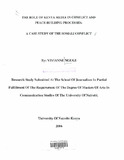| dc.description.abstract | The media occupies a unique position in the society owning to its power over mass
consciousness and its ability to bring to the public's attention, issues that would otherwise
have gone unnoticed. This role has been informed by the way in which they are able to
shape our perceptions and our agendas. The mass media present the opportunity to
communicate to large numbers of people while at the same time, the ability to target
particular groups of people. Mass media are structured in a way that they are orchestrated
by special groups of people (reporters), whose intention is to persuade potential audience
of the benefits of their attention and gate keepers (editors), who monitor the information
that flows to the potential audience.
Research acknowledges that people rely on media for information and uses this
information to make decisions about their lives. However, today, the field of
communications appears to be perpetually under construction, as concepts and challenges
emerge. The current meaning of journalism has grown into an entirely news discipline
under the general nomenclature of the new technology. Therefore, the intellectual
discourses over the role of mass communication and hence the media reconciliation and
peace building process is the product of the quest for building positive peace in the long
term. These issues under write many peoples' understanding of the basis for a lasting
peace. Therefore, the framing by the media of an event to a large extend, decides the
framing of the public debate. In this situation, the media image of reconciliation and
peace building event and processes is important. Historically, the agenda-setting theory,
in this study is not a new phenomenon.
The media provides people with views of the world outside their immediate surrounding
from which they form pictures in their hands. Media forces our attention to certain issues
ignoring or giving less priority to others. Although difficulty, and equally challenging,
. this study discusses how the Kenyan media establish and handle conflict events to main
stream the notion of forgiveness and reconciliation, hence building positive peace in the
long-term in Somali. | en |

